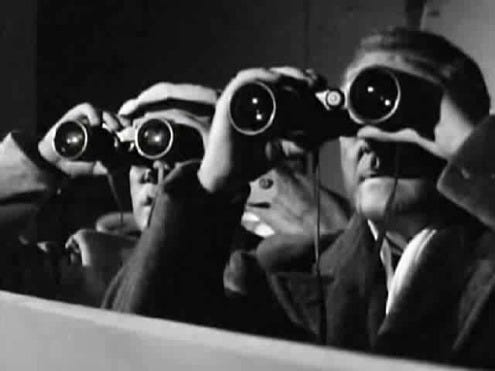Under Ten Flags (1960)

"Under Ten Flags" is a really amazing true-life story that would make a great subject for a movie. But the one that was made is horribly executed.
Consider: During the early days of World War II, before America entered the conflict, a single German merchant ship was converted into the Atlantis — a stealth weapon that singlehandedly destroyed 22 enemy boats. It did so by disguising itself as a harmless fellow merchant vessel, taking its targets by surprise so they rarely even had a chance to get off a radio signal — capturing and/or sinking them with no warning and very little bloodshed. Allied forces and the mighty British navy pursued this "ghost ship" for more than a year, but the brilliant German captain outwitted them again and again.
The saga of the Atlantis is indeed a true tale, one known widely in circles of academics and naval history buffs but novel to most audiences. Unfortunately, the 1960 movie about her exploits is a ham-handed and convoluted mess that unnecessarily piles on sexy girls and a long espionage sequence atop the seafaring adventure.
The title refers to the ability of the Atlantis to disguise itself into ships of different nationalities — carrying paint, lumber, a dummy smokestack funnel and even costumes for the crew members to wear. In the first battle in the movie, the Germans dress in kimonos and pretend to be Japanese women before unfurling their guns and ordering a British merchantman to stand to. In fact, according to the ship's Wikipedia page, it was capable of transforming itself into 26 distinct silhouettes.
Dino De Laurentiis was known at this time as a producer of schlocky Italian movies, and "Under Ten Flags" shows its low-rent roots. The battle sequences are essentially stitched-together pieces of stock footage, including the same ship's guns being fired over and over again. The shipboard sets and backgrounds are cheesy and dull, and the camera is always kept so tightly on the actors we suspect nothing was built more than a foot out of frame.
Van Heflin and Charles Laughton are the stars. Heflin tries to put some oomph into his character, Captain Bernhard Rogge, as the lonely man of integrity in a hellish, dehumanizing war. In fact, that's one of the few ways in which this film stands out, as an early depiction of German heroics during WWII. Even two decades later, "Das Boot" caught plenty of flack for showing members of the Nazi military armada as noble and ingenious.
Laughton, though, looks like he's just collecting a paycheck, scurrying through his dialogue with up-and-down cadences that are often hard to follow. All of his scenes take place inside the British naval command center, which means the most he has to do is occasionally get out from behind his desk and walk down some stairs into the map room to bellow orders.
In all movies showing WWII Germans as anything but uniformly evil, there's always an obligatory flunky who burns with the righteousness of a true believer in the Reich and threatens to report his commander for not wantonly slaying all of Germany's enemies. Here his name is Krüger (John Ericson), who appears to be wearing black eyeliner to depict his character's evil ways.
Perhaps the film's most off-putting aspect is the time spent exploring a few of the prisoners kept aboard the Atlantis. (They cannot be released because they would tell the Allies about the ship's secretive methods.) When they're finally released near the end, they're positively giddy with joy and thank Captain Rogge for his hospitality — a pretty doubtful outcome for people kept forcibly in a dank ship's hold for months on end.
Mylène Demongeot plays Zizi, a Parisian sexpot who cavorts around in short shorts and a hairdo that's Bridget Bardot circa 1960, not a French traveler in 1940. She makes some goo-goo eyes at Krüger, before deciding he's not bold enough to deserve such a hot babe as herself.
There is also a Jewish couple who try unsuccessfully to hide their identity from the Nazis but are protected by Rogge from Krüger's machinations. This is doubtless showbiz hoopla, but curiously the film does not reveal why Rogge might be sympathetic to their case. In real life he had a Jewish grandparent and had to receive special dispensation before he was allowed to serve in the Nazi regime's military forces.
The other big distraction is an extended espionage sequence where an American spy is given plastic surgery to impersonate a German intelligence officer so he can sneak into their Berlin headquarters and steal some navigational codes used to track the Atlantis. It goes on and on, and the payoff is laughably bad.
He gets into the room where the codes are kept in a big safe, with high-tech "infrared beams" ready to set off an alarm. (Again, this seems the sort of thing plausible in 1960 but not 1940.) Wearing special glasses, the spy scoots across the floor between the beams, which are represented in the film as wires or sticks criss-crossing the room. You can even see where they're anchored into the floor!
I have no idea if this whole spy angle is true; screenwriters Vittoriano Petrilli, Duilio Coletti (who also directed), Ulrich Möhr and Leonardo Bercovici worked from the personal diaries of Rogge. What I do know is that it distracts the story completely away from the Atlantis and its travels — although, considering the cheesy and overly self-serious goings-on aboard the Atlantis, perhaps as little time spent there, the better.
2 Yaps



